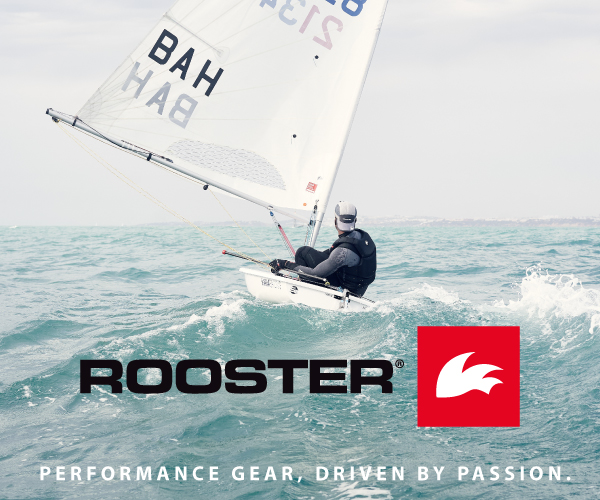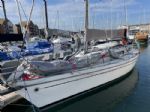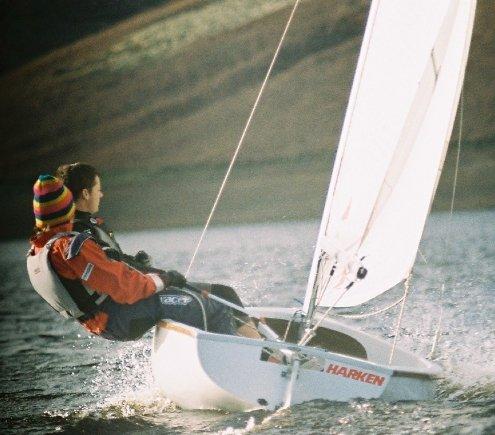











Boats for sale
| Laser 28 - Excellent example of this great design Hamble le rice |
 |
| Rossiter Pintail Mortagne sur Gironde, near Bordeaux |
 |
| Laser 140101 Tynemouth |
 |
List classes of boat for sale |
Starboard Rounding Windward Mark Incident |
Post Reply 
|
Page <12345 7> |
| Author | ||||||||
Brass 
Really should get out more 
Joined: 24 Mar 08 Location: Australia Online Status: Offline Posts: 1151 |
 Post Options Post Options
 Quote Quote  Reply Reply
 Topic: Starboard Rounding Windward Mark Incident Topic: Starboard Rounding Windward Mark IncidentPosted: 16 May 13 at 2:52pm |
|||||||
Yes, rule 18, in its entirity does not apply to boats on opposite tacks on a beat to windward (rule 18.1( a )) Yes the tacking boat must keep clear in accordance with rule 13. No, Rule 18 applies when two boats are on the same tack and at least one of them is in the zone. If rule 18.2( b ) or 18.3 do not apply then rule 18.2( a ) applies: a boat that becomes overlapped inside is entitled to mark-room.
Edited by Brass - 16 May 13 at 2:58pm |
||||||||
 |
||||||||
jeffers 
Really should get out more 

Joined: 29 Mar 04 Location: United Kingdom Online Status: Offline Posts: 3048 |
 Post Options Post Options
 Quote Quote  Reply Reply
 Posted: 16 May 13 at 2:53pm Posted: 16 May 13 at 2:53pm |
|||||||
|
The moral of the story is...don't tack in the zone unless you are damn sure you won't infringe anyone.
I believe this is how the rules were intended to work to discourage people charging in on port and barging their way in. Where is does become interesting is where you have a starboard rounding and a boat approaching on port can lay and pass the mark. The boat on starboard is not allowed to tack at the mark if by doing so the boat on port and no longer keep clear (rule 16.2 if my memory serves correctly....). The defense of this is for the stb boat to slow to force the port boat to tack off (often used in team racing I am told). As for this situation, I think it has been excellently explain by Brass who is know for his extensive knowledge of the rules and clear explanations.
|
||||||||
|
Paul
---------------------- D-Zero GBR 74 |
||||||||
 |
||||||||
Rupert 
Really should get out more 
Joined: 11 Aug 04 Location: Whitefriars sc Online Status: Offline Posts: 8956 |
 Post Options Post Options
 Quote Quote  Reply Reply
 Posted: 16 May 13 at 3:11pm Posted: 16 May 13 at 3:11pm |
|||||||
|
As was said on another thread, the rules are very complex. I guess this is because of the many ways in which boats can meet, and even with all these rules there are situations where maybe the rules don't match a situation perfectly. However, I'm not surprised that many newcomers are put off racing because of them.
|
||||||||
|
Firefly 2324, Puffin 229, Minisail 3446 Mirror 70686
|
||||||||
 |
||||||||
moomin 
Groupie 
Joined: 19 Jan 05 Online Status: Offline Posts: 60 |
 Post Options Post Options
 Quote Quote  Reply Reply
 Posted: 16 May 13 at 3:30pm Posted: 16 May 13 at 3:30pm |
|||||||
Not just team racing you need to be careful approaching a stb rounding mark on stb with a boat coming in on port. You may think you're being considerate by tacking on the mark, hoping that the port boat will be able to luff round your transom and not have to tack. (Particularly in H-cap racing when the 2 boats may not really be racing if there's a big PY gap)
The problem with being "considerate" is that as soon as Stb goes into the tack rule 13/16 kicks in and stb becomes the give way boat.
A bit of consideration does help with h-cap racing when the boat you're encountering at the mark may not be the baot you're in a tight race with, but ensure both parties are aware of what's going to happen!
|
||||||||
|
Moomin
|
||||||||
 |
||||||||
RS400atC 
Really should get out more 
Joined: 04 Dec 08 Online Status: Offline Posts: 3011 |
 Post Options Post Options
 Quote Quote  Reply Reply
 Posted: 16 May 13 at 3:57pm Posted: 16 May 13 at 3:57pm |
|||||||
So R18 starts to apply when the second boat has tacked onto port. By which time it is too late for the first boat to establish an overlap. So once the second boat is to leeward on port, the first boat has only the right to room to keep clear and can be sailed the wrong side of the mark? Does not seem equitable, but the rules appear to say that. I think this is why marks are supposed to be left to port. To change the scenario slightly, if the stbd boat dipped the stern of the port boat inside the zone would you give him an inside overlap? |
||||||||
 |
||||||||
Brass 
Really should get out more 
Joined: 24 Mar 08 Location: Australia Online Status: Offline Posts: 1151 |
 Post Options Post Options
 Quote Quote  Reply Reply
 Posted: 16 May 13 at 4:08pm Posted: 16 May 13 at 4:08pm |
|||||||
Rupert, The rules are not that complex. The Part 2 When Boats Meet rules occupy only six well-spaced A5 pages. Add 2 pages for Basic Principles and Part 1 Fundamental Rules if you wish. There are numerous simplified/shortened rules guides. What might put newcomers off is people endlessly telling them how complex the rules are.
|
||||||||
 |
||||||||
Brass 
Really should get out more 
Joined: 24 Mar 08 Location: Australia Online Status: Offline Posts: 1151 |
 Post Options Post Options
 Quote Quote  Reply Reply
 Posted: 16 May 13 at 5:02pm Posted: 16 May 13 at 5:02pm |
|||||||
Are we talking about the OP scenario diagrammed by Quagers thus:  Here, no boat tacks onto port. Rule 18 begins to apply when Blue passes head to wind and both boats come to be on the same (starboard) tack.
By 'first boat' I take it you mean Yellow. There is very little Yellow can do to influence whether she becomes overlapped or not. Yellow's tactical objective is to gain an inside overlap on Blue so that she is entitled to mark-room. It depends on Blue's judgement and boat handling whether Blue can achieve that or not.
NO, once both boats are on the same tack in the zone, whichever boat is overlapped inside is entitled to mark-room. If Yellow is clear astern, she is give way boat (rule 12), as you say, entitled to room to keep clear (rule 16.1), but in that case, all she does is trails Blue around the mark. If Yellow can get her inside overlap, she would become the windward boat, required to keep clear (rule 11), but Blue cannot sail her the wrong side of the mark, because by becoming overlapped, Yellow gains her entitlements to mark-room (rule 18.2( a )). In the diagram @4, Blue is forcing Yellow the wrong side of the mark, and is breaking rule 18.2( a ) by not giving mark-room.
The rules specify the way the game is played: if everybody complies with the rules the game is, by definition fair and equitable. Would you like to explain how and why you think one boat or another is unfairly advantaged or disadvantaged?
Marks are not 'supposed' to be left to port. Marks are supposed to be left on whichever side the SI specifies they must be left on. In windward/leeward fleet racing, windward marks are usually specified to be left to port, because it is thought that this diminishes protest incidents. Paul Elvstrom has always been a strong opponent of port rounding courses (Elvstrom Explains, Explanatory (Red) Section Rule 89.2)
If Yellow on starboard had dipped below the stern of Blue, then Blue would have probably ended up on her close hauled course, overlapped inside Yellow, entitled to mark-room. But why would Yellow be so foolish?
|
||||||||
 |
||||||||
Jack Sparrow 
Really should get out more 

Joined: 08 Feb 05 Location: United Kingdom Online Status: Offline Posts: 2965 |
 Post Options Post Options
 Quote Quote  Reply Reply
 Posted: 16 May 13 at 6:43pm Posted: 16 May 13 at 6:43pm |
|||||||
LOL... that's why this protracted discussion is taking place ins't it... because the interpretation of the rules is so simple, for what looks like a simple rules situation. I can tell you from first hand experience of novice sailors, that no one is ramming the concept down there throats that the rules of sail are complex. They create that experience all for themselves just by going through the training process and experiencing them for themselves. Brass... you obviously get a kick out of this sort of thing and your mind is predisposed to enable quick visualisation of sailing rules, and that's great. But one hell of a lot of people find them dam confusing! Especially as they get updated every few years. |
||||||||
 |
||||||||
knotty78 
Newbie 
Joined: 09 Mar 13 Online Status: Offline Posts: 10 |
 Post Options Post Options
 Quote Quote  Reply Reply
 Posted: 16 May 13 at 7:01pm Posted: 16 May 13 at 7:01pm |
|||||||
|
isn't this covered by
18.3,18.3 Tacking in the Zone If a boat in the zone passes head to wind and is then on the same tack as a boat that is fetching the mark, rule 18.2 does not thereafter apply between them. The boat that changed tack (a) shall not cause the other boat to sail above close-hauled to avoid contact or prevent the other boat from passing the mark on the required side, and (b) shall give mark-room if the other boat becomes overlapped inside her. |
||||||||
 |
||||||||
Quagers 
Far too distracted from work 

Joined: 24 Oct 06 Location: United Kingdom Online Status: Offline Posts: 279 |
 Post Options Post Options
 Quote Quote  Reply Reply
 Posted: 16 May 13 at 7:24pm Posted: 16 May 13 at 7:24pm |
|||||||
|
No, Knotty The boats still need to tack to round the mark so neither of them is fetching it. So 18.3 does not apply.< id="adlesse_unifier_magic_element_id" style="display:none;">
I must admit this has caught me out a bit, I have done quite a bit of team racing as well as a bit of umpiring and I had always assumed it hinged on the overlap when R.18 'switches on' which now seems to be wrong. The rules are written predominately with fleet racing in mind where it makes some sense to penalise people taking in the zone but it doesn't work so well for team racing. If a boat laying the mark on port with time to burn and a mark trap to do bears off, tacks in the zone and waits to do the trap they are completely vulnerable as all a boat has to do is get a windward overlap and they get room. No matter if port had been sitting there for some while.
|
||||||||
 |
||||||||
Post Reply 
|
Page <12345 7> |
| Forum Jump | Forum Permissions  You cannot post new topics in this forum You cannot reply to topics in this forum You cannot delete your posts in this forum You cannot edit your posts in this forum You cannot create polls in this forum You cannot vote in polls in this forum |
Bulletin Board Software by Web Wiz Forums® version 9.665y
Copyright ©2001-2010 Web Wiz
Change your personal settings, or read our privacy policy
Copyright ©2001-2010 Web Wiz
Change your personal settings, or read our privacy policy











 Printable Version
Printable Version Delicious
Delicious Digg
Digg Facebook
Facebook Furl
Furl Google
Google MySpace
MySpace Newsvine
Newsvine reddit
reddit StumbleUpon
StumbleUpon Twitter
Twitter Windows Live
Windows Live Yahoo Bookmarks
Yahoo Bookmarks Topic Options
Topic Options